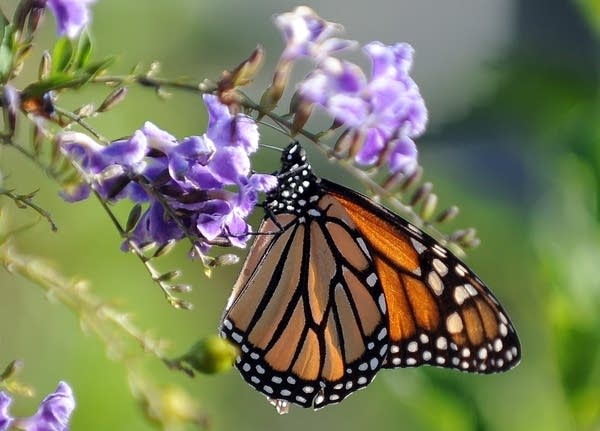Hoping your butterfly release will boost monarch population? Not quite, study says

Go Deeper.
Create an account or log in to save stories.
Like this?
Thanks for liking this story! We have added it to a list of your favorite stories.
Monarchs — Minnesota's state butterfly — spend the summer across North America and migrate to Mexico in the fall to avoid freezing temperature up north.
Despite an increase in the population this year, the number of North American monarchs making that migration has been falling dramatically over the past 20 years. And if monarchs don't migrate, they die.
So, releasing monarchs has become a popular activity for science classes and at events like weddings and birthdays — in part as a way to help boost the species' population.
But new research released Monday suggests it's unlikely those butterfly releases are helping.
Turn Up Your Support
MPR News helps you turn down the noise and build shared understanding. Turn up your support for this public resource and keep trusted journalism accessible to all.
University of Chicago graduate student Asye Tenger-Trolander studied the migration patterns of two groups of monarchs: One group was made up of wild butterflies she captured around Chicago, and the other group of butterflies was purchased from a commercial monarch breeder.
She raised both groups in identical conditions outdoors. In the fall, she tested them in a monarch flight simulator to see which direction they would fly.
"The wild North American group is very much flying south. [It's] very clear that they're going south, whereas the [group with] commercial lineage is very clearly not going in any particular direction," said Tenger-Trolander.
Scientists recognize at least four genetically distinct wild monarch populations: North America, Central/South America, Pacific and Atlantic.
Tenger-Trolander says she found that the commercially raised monarchs were genetically different from all of the wild populations. It's likely, she said, that being raised in a controlled environment for generations has eliminated their genetic drive to migrate.
In a second experiment designed to analyze environmental effects on migration, Tenger-Trolander raised two groups of wild monarchs: one outdoors and the other indoors, under simulated outdoor conditions.
"The outdoor-reared individuals did their sort of normal thing. They went south as a group, and then the indoor group did not. They were kind of very random in the directions that they flew," said Tenger-Trolander.
She was surprised by the results: She'd tried to mimic a fall outdoor environment for the monarchs she had raised indoors, in hopes that the butterflies would have a similar experience to that of their counterparts raised outdoors.
She doesn't know why, but the indoor monarchs clearly did not feel the urge to head south.

Karen Oberhauser, who has published dozens of research papers on monarchs, said this research is a reality check, especially for people who buy and release monarchs.
"We shouldn't be telling people that they're helping the monarch population by doing that. We're not being truthful if we tell people that their rearing monarchs, and especially their buying monarchs from commercial operations, will help the monarch population," said Oberhauser, the former director of the University of Minnesota's monarch lab. She now runs the arboretum at the University of Wisconsin-Madison.
Oberhauser has long raised concerns about commercially raised monarchs introducing disease into the wild monarch population. She said Tenger-Trolander's research shows the potential for to spread undesirable genetic traits by releasing commercially bred monarchs into the wild, where they might breed with wild populations.
"Under the best-case scenario, they'll just die and just not do very well in the wild. But under a worst-case scenario, if lots and lots and lots of them are released, they have the potential of breeding with wild-type monarchs and possibly having a negative impact on the population," said Oberhauser.
"I think [that] creates such a connection to nature in general," Tenger-Trolander said. But, she adds: "We have some caveats if you do want them to have the best chance of going to Mexico ... and that would be essentially collecting your own eggs and then basically raising them outdoors."
Tenger-Trolander's research was published this week in the Proceedings of the National Academy of Sciences. She said it raises many questions about how genetics and environmental factors influence monarch migration that she hopes will be examined in future studies.


